If there’s one thing that all parents want for their children, it’s for them to be successful in life. One of the key ways to achieve success is to give your children a strong foundation in education. And when it comes to mathematics, nothing can help children understand complex ideas like manipulatives can. This blog post will discuss how manipulatives can help children understand complex math ideas and why they are so valuable in the classroom. We’ll also provide tips on using manipulatives at home to help your child with math homework. So keep reading to learn more!
What Are Manipulatives?
Manipulatives are objects that can be moved or manipulated to help children learn. They come in various shapes and sizes and can be used to help explain everything from basic addition and subtraction to more complex concepts. Manipulatives can be used with students of all ages, from preschoolers just learning to count to high school students studying advanced algebra.
For example, using manipulatives like blocks can help children visualize what it means to add numbers together. This can make it easier for them to understand the concept and perform calculations correctly. While manipulatives are most used for younger children when they are learning division, fractions, and other mathematical concepts, older students can also benefit greatly from them. Some advanced math concepts that can be done with math manipulatives include:
- Area, volume, and surface area (snap cubes, power polygons)

- Exponents (two-sided counters)

- Operations with decimals (base 10 blocks)
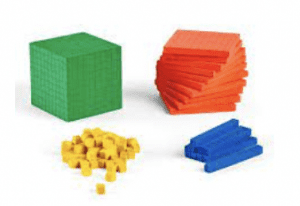
- Operations with fractions (fractions strips, relational rods)
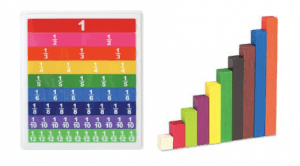
- Square roots (graph paper and square arrays)
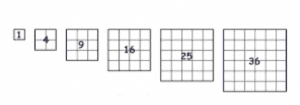
- Ratios (snap cubes, pattern blocks)
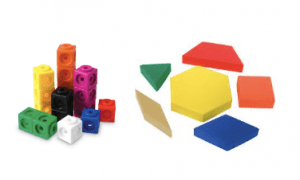
- Algebraic properties (algebra tiles)
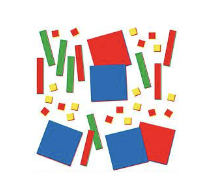
- Operations with polynomials (algebra tiles)

- Operations with negative and positive numbers (two-sided counters)
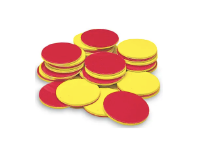
A Positive Attitude
If you are thinking of using manipulatives with your child to help with their math education, your involvement and positive attitude are vital to success as a parent. Even if you are suffering from math anxiety, staying engaged and willing to learn along with your child using manipulatives is important. You will be delighted to see that your child’s understanding increases as your engagement and learning increase.
At Dropkick Math, we believe a child’s success can largely depend on the involvement of the parent/guardian. All of our programs offer the option for parents to become involved and learn alongside their children.
Visually Simple
Math manipulatives are traditionally visually simple as research has shown how detail such as that found on play money can easily distract children. Education professionals have carefully designed manipulatives to help bridge the gap between concrete and abstract concepts.
Why Math Manipulatives Work
So why might a child learn math concepts using the aid of manipulatives better than if they try to solve it in a symbolic form? Researchers think it may be because children think more concretely than adults. They typically rely on physically interacting with the world to make sense of it, and their ability to think abstractly is extremely limited. Some education specialists believe it is because children are in an operational stage from age 7 to 12, where they need to use concrete objects to support logical reasoning. A child can think using pure abstractions in the formal operations stage from age 12 and up.
Another theory as to why manipulatives work suggests it is because they help to move the body. It is suggested that cognition is not just a product of the mind, but the body also participates. For example, children may have a perception of what the word “kick” means, but the meaning of the work becomes solidified when they experience the feeling of kicking something.
By this account, it isn’t so much the manipulatives themselves that help children understand math concepts, but the movement behind them. If this theory is true, many people ask if computer-aided manipulatives can be as helpful as the real thing. There are exceptions, but computer-based manipulatives have been found to help just as much as physical ones.
While more research is needed to understand how manipulatives work and which theories are entirely accurate, one fact remains the same; manipulatives will always lead to better understanding.
Why Math Manipulatives Are Beneficial
Math manipulatives are beneficial for students for a few reasons. First, they provide a hands-on way for students to interact with the material and better understand number sense. For tactile learners, this can help children gain a better understanding of math concepts.
Second, math manipulatives can be reused multiple times, which helps students learn new concepts as they build on what they have already learned. Math is a subject that builds upon itself, and manipulatives offer an excellent opportunity for children to learn how new concepts add to existing ones they have already mastered.
Finally, math manipulatives can be fun and engaging, making learning math more enjoyable for students. In any math illustration, children will understand that manipulatives are playful tools that will help them understand ideas differently. Educators have confirmed that sorting, measuring, distinguishing patterns, and ordering numerals have been very effective with a conceptual understanding of math.
When To Stop Using Manipulatives
Math manipulatives intend not to make children forever dependent on them but to use them as they work through complex problems. For example, high school students should not be pulling out a string of beads as they prepare for a math test. Although extremely helpful when first learning math concepts, math manipulatives can be time-consuming and inconvenient. However, when trying to understand a new idea, children should practice with the manipulatives until they can demonstrate the concept without the manipulatives.
They do have their purpose as students grow through high school and university when a new concept is introduced. Older students often find manipulatives helpful when articulating their thought processes when trying to explain a complex concept. When a new concept is introduced, the process of developing understanding strengthens by connecting concrete manipulatives to visual and symbolic representations. When the student is able to connect the different representations to symbolic form, they should be able to stop using the manipulatives.
Many students find math difficult and frustrating, but using manipulatives can help to make it more accessible and enjoyable. So, if your child struggles with mathematics, try getting some manipulatives to use at home!
Online Math Help
Dropkick Math is a unique tutoring company offering online math help to students who may have experienced an education gap caused by the pandemic. We encourage students to use math manipulatives as a way to understand complex math ideas. Learn more about our programs and if they are the right fit for your child.





